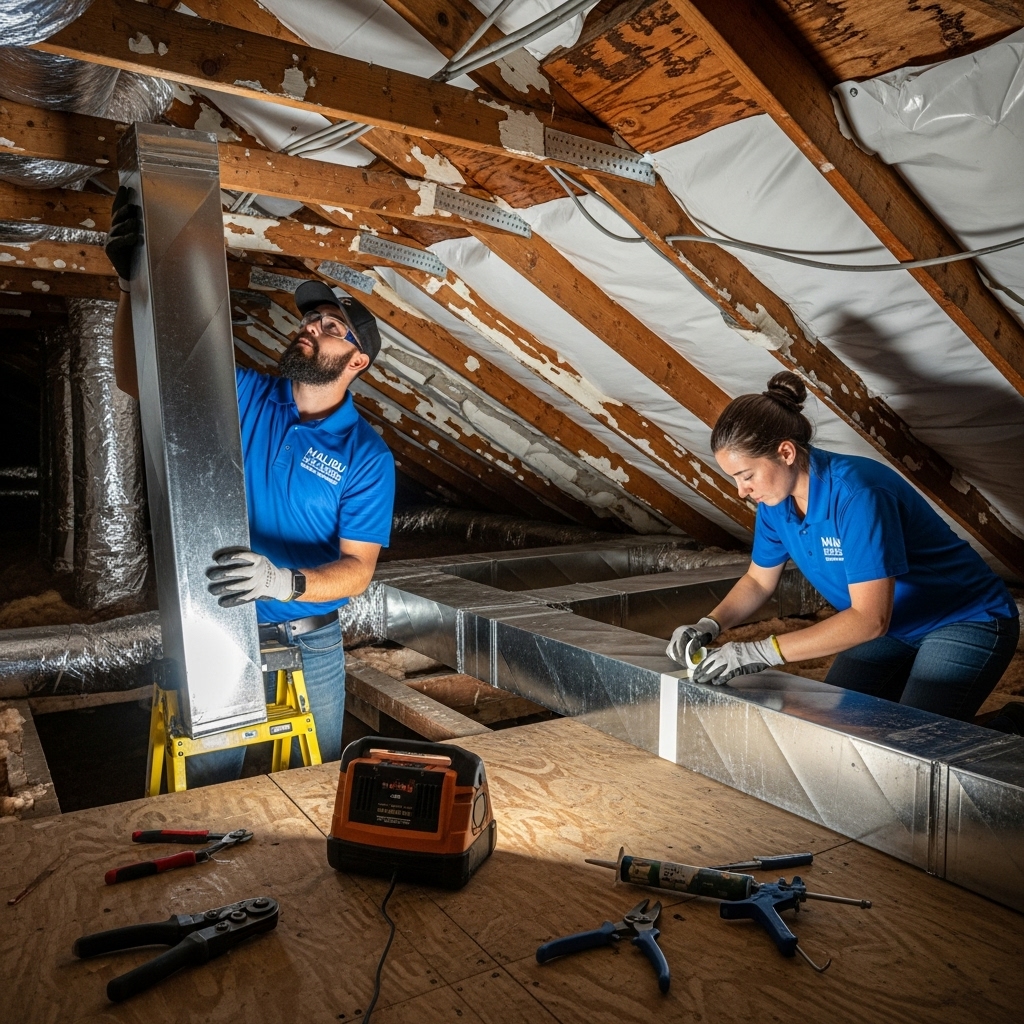Replacing ducts in a Malibu home is a detailed process that blends design, logistics, and craftsmanship. From initial assessment to final balancing, each step builds toward a system that delivers even temperatures, quiet operation, and clean air in a coastal environment. This step-by-step guide explains what happens at each stage, what decisions you will be asked to make, and how to prepare your home. To start on the right foot, review the basics of duct replacement so you can follow along with confidence and ask informed questions throughout the project.
Malibu’s combination of salt air, varying humidity, and hillside layouts makes planning especially important. Access constraints in attics and crawlspaces, attention to sealing and insulation, and a commitment to airflow balancing all shape the outcome. The steps below help you anticipate the sequence and set realistic expectations.
Step 1: Assessment and Documentation
The project begins with a comprehensive review of your current system. The team should note equipment details, measure static pressure, and document room-by-room comfort complaints. Photos of attics, crawlspaces, and mechanical areas help planners understand routing options, support strategies, and potential obstructions.
- Identify problem rooms: Hot or cold spots, drafts, or noise.
- Check returns: Look for undersized or obstructed paths that cause pressure swings.
- Inspect visible runs: Corrosion, crushed sections, or disconnected joints.
- Review filtration: Current filter sizes and cabinet location.
Clear inputs allow the design phase to proceed with fewer assumptions, reducing surprises during installation.
Step 2: Design and Material Selection
With data in hand, the team develops a design that targets smooth airflow and balanced returns. Malibu homes often benefit from rigid metal trunks paired with short, well-supported flex connections in tight spaces. Sealing strategy, insulation levels, and corrosion-resistant fasteners are specified to suit coastal conditions.
- Right-size trunks and branches: Avoid restrictive runs and high velocities that cause noise.
- Optimize diffuser placement: Prevent drafts and improve mixing in large rooms.
- Plan returns strategically: Provide sufficient capacity and clear paths even with doors closed.
- Detail sealing and insulation: Address boots, penetrations, and transitions to maintain envelope integrity.
Step 3: Permits and Scheduling
Local requirements typically call for permits and inspections. Your provider coordinates paperwork and sets a schedule that includes decision checkpoints. Coordinating with other work—like attic insulation upgrades or electrical adjustments—can save time and reduce disruption.
Step 4: Protection and Staging
Before work begins, crews protect floors and furnishings and stage tools and materials. Registers and grills are removed and stored safely. Pathways to attics and mechanical rooms are defined to minimize dust and traffic through living spaces.
Step 5: Removal of Old Ductwork
Careful removal prevents damage to framing and finishes. As old ducts come out, hidden issues may appear: compressed insulation, previous rodent activity, or blocked chases. The team notes these findings and discusses any needed adjustments to routes or materials.
Step 6: Installation of New Runs
New trunks and branches are installed according to the design plan, with attention to support spacing, gentle bends, and airtight connections. In Malibu’s environment, corrosion-resistant fasteners and meticulous sealing protect longevity. Insulation is applied to maintain full coverage without compression, especially at boots and penetrations.
- Maintain gentle sweeps on turns and minimize sharp elbows.
- Support flex at regular intervals to prevent kinks and sagging.
- Seal all joints, seams, and transitions thoroughly.
- Verify that returns are unobstructed and appropriately sized.
Step 7: Balancing and Testing
With installation complete, the team measures supply and return airflow, adjusts dampers, and checks static pressure. This process ensures each room receives targeted airflow and that the system operates quietly. Documentation of readings provides a performance baseline for future maintenance.
Step 8: Final Walkthrough and Maintenance Plan
Before wrapping up, your provider should walk you through the system, explain filter sizes and change intervals, and point out access points for future service. You should also receive notes or drawings that capture as-built routes and register locations.
Homeowner Preparation Checklist
- Clear access to attics, closets, and mechanical rooms.
- Protect stored items in areas adjacent to work zones.
- Arrange pet care or safe spaces during installation hours.
- Discuss daily start/stop times and site access preferences with the crew.
Quality Standards to Expect
High-quality ductwork shares consistent traits: airtight joints, full insulation coverage, proper support spacing, and measured airflow. Registers sit flush and secure, returns are quiet and unobstructed, and transitions are smooth. You should not see excessive kinks, long unsupported flex runs, or compressed insulation.
Common Challenges and How to Handle Them
Every home has quirks. Tight framing may require creative routing; existing beams or plumbing might force slight relocations of registers. With a well-structured design and open communication, these challenges can be addressed without compromising performance. Build decision checkpoints into the schedule so you can weigh options without rushing.
Noise Control Strategies
If quiet operation is a priority, tell your provider up front. Strategies include sizing returns generously, using smooth transitions, choosing appropriate diffusers, and maintaining velocities within recommended ranges. In certain cases, lined sections on specific runs can help with attenuation.
Air Quality Considerations in Malibu
Coastal humidity and occasional smoke events make sealing and filtration especially important. Proper return placement helps prevent drawing air from garages or attics. If you have sensitivities, discuss filter options and cabinet sizing to support both clean air and strong airflow.
Frequently Asked Questions
Q: How long does the process take?
A: Duration depends on home layout, access conditions, and scope. Projects move faster with clear access and when decision checkpoints are defined in advance.
Q: Can some existing ducts be reused?
A: Sometimes. Sections must be inspected for size, condition, and compatibility. Reusing restrictive or damaged runs can undermine results.
Q: Do I need to leave the home?
A: Usually not, but expect activity in attics, crawlspaces, and mechanical rooms. Coordinating start/stop times and access pathways keeps daily routines manageable.
Q: What documents should I receive at the end?
A: Expect airflow readings, static pressure checks, filter specifications, and notes or drawings showing as-built routing and register locations.
Q: How do Malibu’s conditions affect materials?
A: Moisture and salt exposure call for robust sealing, proper insulation, and corrosion-resistant fasteners. These details help preserve performance over time.
Aftercare: Protecting Your Investment
Once complete, follow a simple maintenance rhythm: change filters on schedule, keep returns clear, and inspect accessible runs after major weather or smoke events. If you plan additional attic work, let your HVAC provider know so supports and seals are checked afterward.
From Plan to Performance
A successful project follows a logical sequence and pairs thoughtful design with disciplined execution. When each step is done well—assessment, design, permitting, protection, removal, installation, balancing, and walkthrough—the result is a system that quietly delivers comfort and clean air throughout the seasons.
Get Started With Confidence
If you are ready to map out your Malibu project, begin by listing comfort priorities, documenting access conditions, and aligning on a design that fits your home’s layout. Confirm that balancing, documentation, and maintenance guidance are included. To move forward with a clear plan, explore professional duct replacement services and schedule a consultation focused on your goals, timeline, and the unique conditions of Malibu’s coastal environment.

